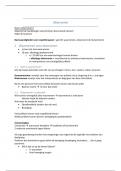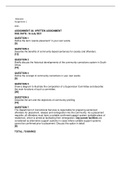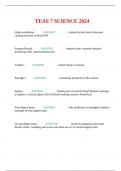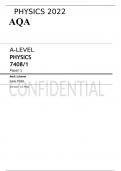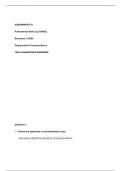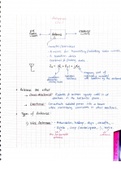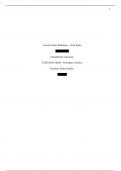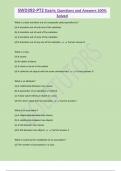HESI Exit Final Real Exam Complete
Q&A 2023 Latest update
While assessing a radial artery catheter, the client complains of numbness and pain distal to the
insertion site. What interventions should the nurse implement? - answer-Promptly remove the arterial
catheter from the radial artery.
A client is admitted with an epidural hematoma that resulted from a skateboarding accident. To
differentiate the vascular source of the intracranial bleeding, which finding should the nurse monitor? -
answer-Rapid onset of decreased level of consciousness.
When preparing a client for discharge from the hospital following a cystectomy and a urinary diversion
to treat bladder cancer, which instruction is most important for the nurse to include in the client's
discharge teaching plan? - answer-Report any signs of cloudy urine output.
After repositioning an immobile client, the nurse observes an area of hyperemia. To assess for
blanching, what action should the nurse take? - answer-Apply light pressure over the area.
The nurse enters a client's room and observes the client's wrist restraint secured as seen in the picture.
What action should the nurse take? - answer-Reposition the restraint tie onto the bedframe.
A female client with acute respiratory distress syndrome (ARDS) is chemically paralyzed and sedated
while she is on as assist-control ventilator using 50% FIO2. Which assessment finding warrants
immediate intervention by the nurse? - answer-Diminished left lower lobe sounds
Rationale: Diminished lobe sounds indicate collapsed alveoli or tension pneumothorax, which required
immediate chest tube insertion to re-inflate the lung.
,The development of atherosclerosis is a process of sequential events. Arrange the pathophysiological
events in orders of occurrence. (Place the first event on top and the last on the bottom) - answer-
Arterial endothelium injury causes inflammation
Macrophages consume low density lipoprotein (LDL), creating foam cells
Foam cells release growth factors for smooth muscle cells
Smooth muscle grows over fatty streaks creating fibrous plaques
Vessel narrowing results in ischemia
Following a motor vehicle collision, an adult female with a ruptured spleen and a blood pressure of
70/44, had an emergency splenectomy. Twelve hours after the surgery, her urine output is 25 ml/hour
for the last two hours. What pathophysiological reason supports the nurse's decision to report this
finding to the healthcare provider? - answer-Oliguria signals tubular necrosis related to hypoperfusion
A nurse-manager is preparing the curricula for a class for charge nurses. A staffing formula based on
what data ensures quality client care and is most cost-effective? - answer-Skills of staff and client acuity
When performing postural drainage on a client with Chronic Obstructive Pulmonary Disease (COPD),
which approach should the nurse use? - answer-Explain that the client may be placed in five positions
A client presents in the emergency room with right-sided facial asymmetry. The nurse asks the client to
perform a series of movements that require use of the facial muscles. What symptoms suggest that the
client has most likely experience a Bell's palsy rather than a stroke? - answer-Inability to close the
affected eye, raise brow, or smile
The nurse is teaching a client how to perform colostomy irrigations. When observing the client's return
demonstration, which action indicated that the client understood the teaching? - answer-Keeps the
irrigating container less than 18 inches above the stoma
The nurse should teach the client to observe which precaution while taking dronedarone? - answer-
Avoid grapefruits and its juice
,A client who sustained a head injury following an automobile collision is admitted to the hospital. The
nurse include the client's risk for developing increased intracranial pressure (ICP) in the plan of care.
Which signs indicate to the nurse that ICP has increased? - answer-Increased Glasgow coma scale score.
Nuchal rigidity and papilledema.
Confusion and papilledema
Periorbital ecchymosis.
Rationale: papilledema is always an indicator of increased ICP, and confusion is usually the first sign of
increased ICP. Other options do not necessarily reflect increased ICP.
The nurse is caring for a client receiving continuous IV fluids through a single lumen central venous
catheter (CVC). Based on the CVC care bundle, which action should be completed daily to reduce the
risk for infection? - answer-Confirm the necessity for continued use of the CVC.
During an annual physical examination, an older woman's fasting blood sugar (FBS) is determined to be
140 mg/dl or 7.8 mmol/L (SI). Which additional finding obtained during a follow-up visit 2 weeks later is
most indicative that the client has diabetes mellitus (DM)? - answer-Repeated fasting blood sugar (FBS)
is 132 mg/dl or 7.4 mmol/L (SI).
A client who was admitted yesterday with severe dehydration is complaining of pain a 24 gauge IV with
normal saline is infusing at a rate of 150 ml/hour. Which intervention should the nurse implement first?
- answer-Stop the normal saline infusion.
An elderly female is admitted because of a change in her level of sensorium. During the evening shift,
the client attempts to get out bed and falls, breaking her left hip. Buck's skin traction is applied to the
left leg while waiting for surgery. Which intervention is most important for the nurse to include in this
client's plan care? - answer-Ensure proper alignment of the leg in traction.
A client who had a right hip replacement 3 day ago is pale has diminished breath sound over the left
lower lung fields, a temperature of 100.2 F, and an oxygen saturation rate of 90%. The client is
scheduled to be transferred to a skilled nursing facility (SNF) tomorrow for rehabilitative critical
, pathway. Based on the client's symptoms, what recommendation should the nurse give the healthcare
provider? - answer-Reassess readiness for SNF transfer.
A client who is newly diagnosed with type 2 diabetes mellitus (DM) receives a prescription for
metformin (Glucophage) 500 mg PO twice daily. What information should the nurse include in this
client's teaching plan? (Select all that apply.) - answer-Recognize signs and symptoms of hypoglycemia.
Report persist polyuria to the healthcare provider.
Take Glucophage with the morning and evening meal.
The nurse is developing an educational program for older clients who are being discharged with new
antihypertensive medications. The nurse should ensure that the educational materials include which
characteristics? Select all that apply - answer-Written at a twelfth grade reading level
Contains a list with definitions of unfamiliar terms
Uses common words with few Syllables
Printed using a 12 point type font
Uses pictures to help illustrate complex ideas
Rationale: During the aging process older clients often experience sensory or cognitive changes, such as
decreased visual or hearing acuity, slower thought or reasoning processes, and shorter attention span.
Materials for this age group should include at least of terms, such as a medical terminology that incline
may not know and use common words that expresses information clearly and simply. Simple, attractive
pictures help hold the learner's attention. The reading level of material should be at the 4th to 5th grade
level. Materials should be printed using large font (18-point or higher), not the standard 12-point font.
During the admission assessment, the nurse auscultates heart sounds for a client with no history of
cardiovascular disease. Where should the nurse listen when assessing the client's point of maximal
impulse (PMI) (Click the chosen location. To change, click on a new location) - answer-Left Fourth
Intercostal Space
Q&A 2023 Latest update
While assessing a radial artery catheter, the client complains of numbness and pain distal to the
insertion site. What interventions should the nurse implement? - answer-Promptly remove the arterial
catheter from the radial artery.
A client is admitted with an epidural hematoma that resulted from a skateboarding accident. To
differentiate the vascular source of the intracranial bleeding, which finding should the nurse monitor? -
answer-Rapid onset of decreased level of consciousness.
When preparing a client for discharge from the hospital following a cystectomy and a urinary diversion
to treat bladder cancer, which instruction is most important for the nurse to include in the client's
discharge teaching plan? - answer-Report any signs of cloudy urine output.
After repositioning an immobile client, the nurse observes an area of hyperemia. To assess for
blanching, what action should the nurse take? - answer-Apply light pressure over the area.
The nurse enters a client's room and observes the client's wrist restraint secured as seen in the picture.
What action should the nurse take? - answer-Reposition the restraint tie onto the bedframe.
A female client with acute respiratory distress syndrome (ARDS) is chemically paralyzed and sedated
while she is on as assist-control ventilator using 50% FIO2. Which assessment finding warrants
immediate intervention by the nurse? - answer-Diminished left lower lobe sounds
Rationale: Diminished lobe sounds indicate collapsed alveoli or tension pneumothorax, which required
immediate chest tube insertion to re-inflate the lung.
,The development of atherosclerosis is a process of sequential events. Arrange the pathophysiological
events in orders of occurrence. (Place the first event on top and the last on the bottom) - answer-
Arterial endothelium injury causes inflammation
Macrophages consume low density lipoprotein (LDL), creating foam cells
Foam cells release growth factors for smooth muscle cells
Smooth muscle grows over fatty streaks creating fibrous plaques
Vessel narrowing results in ischemia
Following a motor vehicle collision, an adult female with a ruptured spleen and a blood pressure of
70/44, had an emergency splenectomy. Twelve hours after the surgery, her urine output is 25 ml/hour
for the last two hours. What pathophysiological reason supports the nurse's decision to report this
finding to the healthcare provider? - answer-Oliguria signals tubular necrosis related to hypoperfusion
A nurse-manager is preparing the curricula for a class for charge nurses. A staffing formula based on
what data ensures quality client care and is most cost-effective? - answer-Skills of staff and client acuity
When performing postural drainage on a client with Chronic Obstructive Pulmonary Disease (COPD),
which approach should the nurse use? - answer-Explain that the client may be placed in five positions
A client presents in the emergency room with right-sided facial asymmetry. The nurse asks the client to
perform a series of movements that require use of the facial muscles. What symptoms suggest that the
client has most likely experience a Bell's palsy rather than a stroke? - answer-Inability to close the
affected eye, raise brow, or smile
The nurse is teaching a client how to perform colostomy irrigations. When observing the client's return
demonstration, which action indicated that the client understood the teaching? - answer-Keeps the
irrigating container less than 18 inches above the stoma
The nurse should teach the client to observe which precaution while taking dronedarone? - answer-
Avoid grapefruits and its juice
,A client who sustained a head injury following an automobile collision is admitted to the hospital. The
nurse include the client's risk for developing increased intracranial pressure (ICP) in the plan of care.
Which signs indicate to the nurse that ICP has increased? - answer-Increased Glasgow coma scale score.
Nuchal rigidity and papilledema.
Confusion and papilledema
Periorbital ecchymosis.
Rationale: papilledema is always an indicator of increased ICP, and confusion is usually the first sign of
increased ICP. Other options do not necessarily reflect increased ICP.
The nurse is caring for a client receiving continuous IV fluids through a single lumen central venous
catheter (CVC). Based on the CVC care bundle, which action should be completed daily to reduce the
risk for infection? - answer-Confirm the necessity for continued use of the CVC.
During an annual physical examination, an older woman's fasting blood sugar (FBS) is determined to be
140 mg/dl or 7.8 mmol/L (SI). Which additional finding obtained during a follow-up visit 2 weeks later is
most indicative that the client has diabetes mellitus (DM)? - answer-Repeated fasting blood sugar (FBS)
is 132 mg/dl or 7.4 mmol/L (SI).
A client who was admitted yesterday with severe dehydration is complaining of pain a 24 gauge IV with
normal saline is infusing at a rate of 150 ml/hour. Which intervention should the nurse implement first?
- answer-Stop the normal saline infusion.
An elderly female is admitted because of a change in her level of sensorium. During the evening shift,
the client attempts to get out bed and falls, breaking her left hip. Buck's skin traction is applied to the
left leg while waiting for surgery. Which intervention is most important for the nurse to include in this
client's plan care? - answer-Ensure proper alignment of the leg in traction.
A client who had a right hip replacement 3 day ago is pale has diminished breath sound over the left
lower lung fields, a temperature of 100.2 F, and an oxygen saturation rate of 90%. The client is
scheduled to be transferred to a skilled nursing facility (SNF) tomorrow for rehabilitative critical
, pathway. Based on the client's symptoms, what recommendation should the nurse give the healthcare
provider? - answer-Reassess readiness for SNF transfer.
A client who is newly diagnosed with type 2 diabetes mellitus (DM) receives a prescription for
metformin (Glucophage) 500 mg PO twice daily. What information should the nurse include in this
client's teaching plan? (Select all that apply.) - answer-Recognize signs and symptoms of hypoglycemia.
Report persist polyuria to the healthcare provider.
Take Glucophage with the morning and evening meal.
The nurse is developing an educational program for older clients who are being discharged with new
antihypertensive medications. The nurse should ensure that the educational materials include which
characteristics? Select all that apply - answer-Written at a twelfth grade reading level
Contains a list with definitions of unfamiliar terms
Uses common words with few Syllables
Printed using a 12 point type font
Uses pictures to help illustrate complex ideas
Rationale: During the aging process older clients often experience sensory or cognitive changes, such as
decreased visual or hearing acuity, slower thought or reasoning processes, and shorter attention span.
Materials for this age group should include at least of terms, such as a medical terminology that incline
may not know and use common words that expresses information clearly and simply. Simple, attractive
pictures help hold the learner's attention. The reading level of material should be at the 4th to 5th grade
level. Materials should be printed using large font (18-point or higher), not the standard 12-point font.
During the admission assessment, the nurse auscultates heart sounds for a client with no history of
cardiovascular disease. Where should the nurse listen when assessing the client's point of maximal
impulse (PMI) (Click the chosen location. To change, click on a new location) - answer-Left Fourth
Intercostal Space

